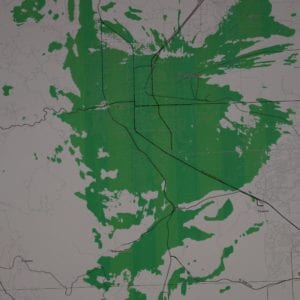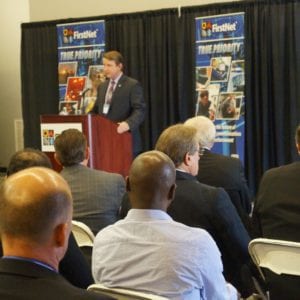BOULDER, Colorado – The First Responders Network Authority opened a testing lab where devices and applications will be evaluated for use on the planned national public safety LTE network.
The new facility has more than 4,600 square feet of lab space, including a Faraday cage for testing devices in isolation and 15 test benches. It has three external antennas generating Band 14 LTE network coverage and test equipment allowing devices and applications to be tested and certified for their capabilities and ability to meet public safety performance and reliability needs before they are accepted into the FirstNet. The Band 14 coverage supports over-the-air testing at FirstNet Lab.

Tiers of cable trays hang overhead, waiting to hold the cabling that will enable network features to be tested. The walls have been painted with a special paint containing carbon fiber to help isolate the radio frequency environment – and make sure FirstNet’s testing doesn’t interfere with either the broader public safety network or the lab’s neighbors’ wireless connectivity.

FirstNet CTO Jeff Bratcher said the lab will establish a list of verified devices which public safety agencies can choose to use on the network, similar to carrier acceptance testing by commercial wireless operators.
“As part of the legislation [that established FirstNet], there is required to be developed a list of certified devices for the network in partnership with [the National Institute of Standards and Technology],” Bratcher said. “So that’s really what we’re gearing up for is to meet that part of the legislation, that we’re required to develop that list of certified devices for public safety use on the network.”
The lab, he said, will be “a foundation for future FirstNet training” as well, where first responders can go through hands-on training and to test out tools such as virtual or augmented reality to assess their usefulness.
“This is their lab. They’re going to be welcome all the time,” said FirstNet CEO Mike Poth. “This is a great, significant milestone for FirstNet.”
In terms of application testing, Bratcher noted FirstNet has a vendor communications outreach team based in Reston, Virginia, and vendors can get more information about potentially testing their apps with FirstNet from its website. FirstNet has outlined its app strategy as “[enabling] creation of new public safety applications while maintaining support for existing commercial applications in order to establish a portfolio of resilient, reliable, secure and easy-to-use applications for first responders.”
Michael Van Zuiden, director of FirstNet Lab, said during a tour of the facility that it is ready for testing immediately. FirstNet’s board had hoped to award the $6.5 billion contract for the network by Nov. 1, but is still working through the award process.
The newly opened lab is set to work closely with the Public Safety Communications Research organization housed at NIST, not far away in Boulder. PSCR has been allocated up to $300 million in funding for research in public safety communications as part of the federal law establishing FirstNet.
[embedyt] http://www.youtube.com/watch?v=qcN5QIJz_pU[/embedyt]
[embedyt] http://www.youtube.com/watch?v=iG39Q9pZaRY[/embedyt]

